Eurozone inflation numbers for October are in. To the relief of many, the numbers came in at 10.6%, lower than expected.
The previous survey, released at the end of October, estimated a record-breaking annual price increase of 10.7%. Inflation in the European Union rose to 11.5%. Prices rose 1.5% in the Eurozone and 1.4% in the EU compared to September 2022.
The HICP (Harmonized Index of Consumer Prices) or core inflation (which excludes prices for energy, food, alcohol, and tobacco) increased by 0.6% each month, or 5% annually. Energy accounted for 4.44 percentage points, followed by food, alcohol, and tobacco (2.74%), services (1.82%), and non-energy industrial products (1.62%).
Energy costs have taken a toll around the world. Just a year ago, in October 2021, energy prices in the Eurozone were 41.5% lower.
Since July, the European Central Bank has been significantly hiking interest rates in an effort to restrain price increases. It aims to maintain inflation at 2% over the medium term.
More interest rate hikes to curb inflation?
The current numbers are far from the target of the European Central Bank. Therefore it is highly likely that interest rate hikes will continue.
Inflation in the United Kingdom (UK) has reached a 41-year high of 11.1%. On the other hand, US October inflation numbers were also lower than expected at 7.7%. However, the number is still higher than the FED’s (Federal Reserve) intended target. Therefore interest rate hikes should be expected globally.
2022 has been one of the worst years for global finance. The Russia-Ukraine war, and the effects of the Covid-19 pandemic, have cost us dearly. According to experts, the current economic slump may last until 2024. Even Tesla CEO, and current owner of Twitter, Elon Musk, believes that a recession may last until the spring of 2024.





